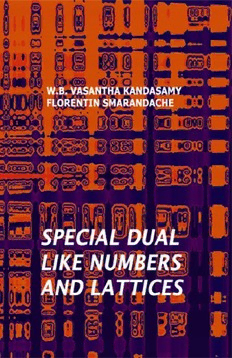
Special Dual like numbers and lattices PDF
Preview Special Dual like numbers and lattices
Special Dual like Numbers and Lattices W. B. Vasantha Kandasamy Florentin Smarandache ZIP PUBLISHING Ohio 2012 This book can be ordered from: Zip Publishing 1313 Chesapeake Ave. Columbus, Ohio 43212, USA Toll Free: (614) 485-0721 E-mail: [email protected] Website: www.zippublishing.com Copyright 2012 by Zip Publishing and the Authors Peer reviewers: Prof. Ken Nagasaka, Tokyo University A&T, Japan. Prof. Gabriel Tica, Bailesti College, Bailesti, Jud. Dolj, Romania. Florentin Popescu, Facultatea de Mecanica, University of Craiova, Romania. Dr. Sebastian Nicolaescu, 2 Terrace Ave., West Orange, NJ 07052, USA. Many books can be downloaded from the following Digital Library of Science: http://www.gallup.unm.edu/~smarandache/eBooks-otherformats.htm ISBN-13: 978-1-59973-185-8 EAN: 9781599731858 Printed in the United States of America 2 CONTENTS Dedication 5 Preface 7 Chapter One INTRODUCTION 9 Chapter Two SPECIAL DUAL LIKE NUMBERS 11 Chapter Three HIGHER DIMENSIONAL SPECIAL DUAL NUMBERS 99 Chapter Four SPECIAL DUAL LIKE NEUTROSOPHIC NUMBERS 139 3 Chapter Five MIXED DUAL NUMBERS 165 Chapter Six APPLICATION OF SPECIAL DUAL LIKE NUMBERS AND MIXED DUAL NUMBERS 199 Chapter Six SUGGESTED PROBLEMS 201 FURTHER READING 240 INDEX 243 ABOUT THE AUTHORS 246 4 D EDICATION A.P.KOTELNIKOV 5 We dedicate this book to A.P. Kotelnikov. The algebra of dual numbers has been originally conceived by W.K. Clifford, but its first applications to mechanics are due to A.P. Kotelnikov. The original paper of A.P. Kotelnikov, published in the Annals of Imperial University of Kazan (1895), is reputed to have been destroyed during the Russian revolution. 6 PREFACE In this book the authors introduce a new type of dual numbers called special dual like numbers. These numbers are constructed using idempotents in the place of nilpotents of order two as new element. That is x = a + bg is a special dual like number where a and b are reals and g is a new element such that g2 =g. The collection of special dual like numbers forms a ring. Further lattices are the rich structures which contributes to special dual like numbers. These special dual like numbers x = a + bg; when a and b are positive reals greater than or equal to one we see powers of x diverge on; and every power of x is also a special dual like number, with very large a and b. On the other hand if a and b are positive reals lying in the open interval (0, 1) then we see the higher powers of x may converge to 0. Another rich source of idempotents is the Neutrosophic number I, as I2 = I. We build several types of finite or infinite rings using these Neutrosophic numbers. We also define the 7 notion of mixed dual numbers using both dual numbers and special dual like numbers. Neither lattices nor the Neutrosophic number I can contribute to mixed dual numbers. The two sources are the linear operators on vector spaces or linear algebras and the modulo integers Z ; n a suitable composite n number, are the ones which contribute to mixed dual numbers. This book contains seven chapters. Chapter one is introductory in nature. Special dual like numbers are introduced in chapter two. Chapter three introduces higher dimensional special dual like numbers. Special dual like neutrosophic numbers are introduced in chapter four of this book. Mixed dual numbers are defined and described in chapter five and the possible applications are mentioned in chapter six. The last chapter has suggested over 145 problems. We thank Dr. K.Kandasamy for proof reading and being extremely supportive. W.B.VASANTHA KANDASAMY FLORENTIN SMARANDACHE 8 Chapter One INTRODUCTION In this book the authors for the first time introduce the new notion of special dual like numbers. Dual numbers were introduced in 1873 by W.K. Clifford. We call a number a + bg to be a special dual like number if a, b R (or Q or Z or C) and g is a new element such that n g2 = g. We give examples of them. The natural class of special dual like numbers can also be got from Z I = {a + bI | a, b Z, I2 = I , I the indeterminate} (Q I or Z I or R I or C I). n Thus introduction of special dual like numbers makes one identify these neutrosophic rings as special dual like numbers. Apart from this in this book we use distributive lattices to build the special dual like numbers. For S = {a + bg | a, b R and g L, L a lattice} paves way to a special dual like number as g g = g and g g = g that is every element in L is an idempotent under both the operations
